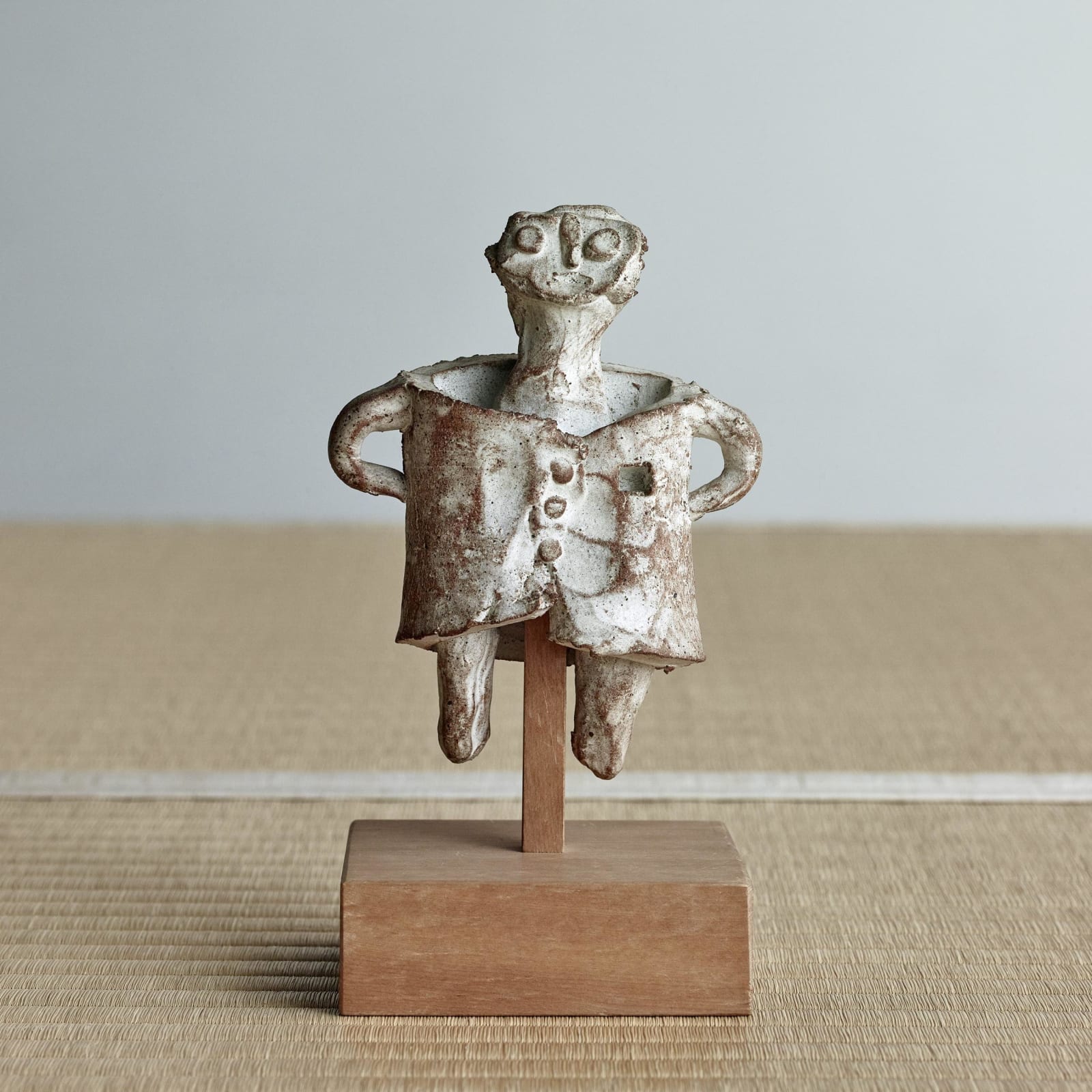Isamu Noguchi (1904–1988)
Ningyō
Stoneware
Incised “no” on the back
1952
With a certificate of authenticity by the artist
W13 x H24 cm (incl. stand)
Further images
Ningyo was made in 1952, which marked the culmination of three years when Isamu Noguchi extensively worked in Japan. After holding an exhibition at the Mitsukoshi Department Store in Nihonbashi (Tokyo) in 1950, he visited again in 1951 to explore design opportunities for the Hiroshima Peace Park, and to develop the first of his Akari light sculptures. In early 1952, Noguchi settled for about half a year at the premises of the calligrapher and ceramic artist Kitaoji Rosanjin in Kita-Kamakura. This time, he was accompanied by the actress Yoshiko (Shirley) Yamaguchi, whom he married in May, and the couple moved into an apparently idyllic, secluded life of art and nature at Rosanjin’s grounds, not far away from the ocean.
The results of several months of intense work were presented in a large solo exhibition at the new Kanagawa Prefectural Museum of Modern Art in Kamakura in the fall of the same year. Ningyo doubtlessly belongs in the context of this ground-breaking exhibition, but it is difficult to say with certainty if it was among the exhibits or not. The catalog’s work list comprises 119 ceramics, out of which 61 are described as “sculpture,” but only a handful are featured with photographs; moreover, a work of the title Ningyo is not in the list.
There are, however, a few indicators that underscore the connection. Ningyo appears like a straightforward companion piece to Yoshiko-san No. 2 in terms of texture, its simplified features and the hiragana character no (for “Noguchi”) that marks it on the back and is scattered all over the kimono of Yoshiko-san No. 2. Family and love are important themes among Noguchi’s ceramic sculptures: two works, Yoshiko-san No. 1 and Yoshiko-san No. 2, portray Noguchi’s wife, at least two more represent a married couple (Marriage and Senbei buton, likely showing Noguchi himself and his wife), one shows his brother Michio (Bachelor) and several more pieces represent children. It is tempting to speculate if this preoccupation with a fulfilled family life is perhaps was an inverted reflection of Noguchi coming to terms with the memory of his Japanese father whom he remembered as painfully distant, or maybe just an expression of his newfound happiness.
If one allows for the possibility that the artist changed the title later, it would be not inconceivable that Ningyo originally represented Noguchi himself. Perhaps it corresponds to Myself No. 1, listed as catalog number 76, in the same section (“Shigaraki”) as Yoshiko-san No. 2. Noguchi and Yoshiko Yamaguchi separated in 1957, and maybe by then Noguchi did not want to see a work that constitutes a companion to Yoshiko-san No. 2 as “himself” anymore. In that sense, Ningyo might be a highly personal work.
Isamu Noguchi (sculptor; 1904–1988)
American sculptor, born in Los Angeles. Noguchi’s father was the Japanese poet Noguchi Yonejiro, his mother was the writer Leonie Gilmore. He initially studied medicine at Columbia University, but then decided to become a sculptor. Traveling extensively, including Europe, China, and Japan, Noguchi eventually expanded into designing public spaces, gardens, and furniture. His work is influential for introducing Japanese sensibilities into American art, but also for contributing to the spread of modernism in sculpture and ceramics in Japan.
The results of several months of intense work were presented in a large solo exhibition at the new Kanagawa Prefectural Museum of Modern Art in Kamakura in the fall of the same year. Ningyo doubtlessly belongs in the context of this ground-breaking exhibition, but it is difficult to say with certainty if it was among the exhibits or not. The catalog’s work list comprises 119 ceramics, out of which 61 are described as “sculpture,” but only a handful are featured with photographs; moreover, a work of the title Ningyo is not in the list.
There are, however, a few indicators that underscore the connection. Ningyo appears like a straightforward companion piece to Yoshiko-san No. 2 in terms of texture, its simplified features and the hiragana character no (for “Noguchi”) that marks it on the back and is scattered all over the kimono of Yoshiko-san No. 2. Family and love are important themes among Noguchi’s ceramic sculptures: two works, Yoshiko-san No. 1 and Yoshiko-san No. 2, portray Noguchi’s wife, at least two more represent a married couple (Marriage and Senbei buton, likely showing Noguchi himself and his wife), one shows his brother Michio (Bachelor) and several more pieces represent children. It is tempting to speculate if this preoccupation with a fulfilled family life is perhaps was an inverted reflection of Noguchi coming to terms with the memory of his Japanese father whom he remembered as painfully distant, or maybe just an expression of his newfound happiness.
If one allows for the possibility that the artist changed the title later, it would be not inconceivable that Ningyo originally represented Noguchi himself. Perhaps it corresponds to Myself No. 1, listed as catalog number 76, in the same section (“Shigaraki”) as Yoshiko-san No. 2. Noguchi and Yoshiko Yamaguchi separated in 1957, and maybe by then Noguchi did not want to see a work that constitutes a companion to Yoshiko-san No. 2 as “himself” anymore. In that sense, Ningyo might be a highly personal work.
Isamu Noguchi (sculptor; 1904–1988)
American sculptor, born in Los Angeles. Noguchi’s father was the Japanese poet Noguchi Yonejiro, his mother was the writer Leonie Gilmore. He initially studied medicine at Columbia University, but then decided to become a sculptor. Traveling extensively, including Europe, China, and Japan, Noguchi eventually expanded into designing public spaces, gardens, and furniture. His work is influential for introducing Japanese sensibilities into American art, but also for contributing to the spread of modernism in sculpture and ceramics in Japan.





